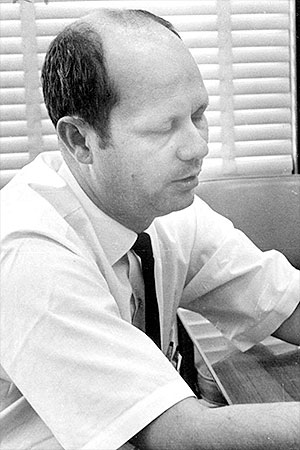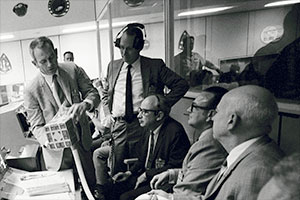April 27, 2025 — It was about one in the morning, four hours after an explosion tore through the Apollo 13 spacecraft on its way to the moon, when Ed Smylie realized they had to do something about the carbon dioxide. What happened next is now storied space history, involving how to fit a square peg into a round hole.
Smylie, who was chief of NASA's crew systems division at the time, died on April 21, 2025, at the age of 95. His death came almost 55 years to the day after he and his team figured out how to combine a spacesuit hose, a sock, a plastic bag, cue cards and duct tape to clean the air for astronauts Jim Lovell, Fred Haise and Jack Swigert during their emergency trip back to Earth.
"I guess that was our 15 minutes of fame," said Smylie in an 1999 interview with a NASA historian. "If you read the book and look at the movie ["Apollo 13"], it sounds like I did all of that. I went back and looked at the list of people that I identified were involved, and there was probably 60 people involved in one way or another."
The concern was that the carbon dioxide being exhaled by the astronauts would reach high enough concentrations to be deadly if not cleaned from the air. The Apollo spacecraft had two areas where the crew lived and each were built by different contractors. Inside the command module, the carbon dioxide scrubber (or lithium hydroxide canister, as it was technically known) was cube-shaped. In the lunar module, which on Apollo 13 served as the crew's lifeboat, the scrubber was cylindrical.
Initially, Smylie thought that the solution could be as simple as continuing to run the scrubbers in the command module and run hoses to redirect their cleaned air exhaust into the lunar module. That would have worked had the command module not needed to be shut down to reserve power for the reentry into the atmosphere (only the command module was designed to return to Earth intact).
After working with others to come up with the basic concept, Smylie and his team needed to make sure that it would work.
"I called both Downey and Kennedy [Space Center] and asked for some canisters to be sent so we could test that," said Smylie, referencing the location of North American Rockwell, NASA's contractor for the command module. "We found them at the Cape, chartered an airplane — Grumman [NASA's contractor for the lunar module] chartered an airplane, I guess, or North American did, and flew them up, and we had them that afternoon."
After learning that their makeshift fix worked as intended, they needed to come up with how to tell the Apollo 13 crew how to build the so-called "mail box" in space.
"We got hold of T.K.," said Smylie, referring to Thomas "Ken" Mattingly, who until three days before the mission had been assigned to fly with Lovell and Haise, but was grounded after he was exposed to the German measles. "T.K. was busy doing other things and he assigned [another astronaut] Tony England to work with us on developing procedures to send up to the crew on how to build this thing."
Although the jury-rigged solution sounded complex, Smylie said that it was "pretty straightforward."
"Even though we got a lot of publicity for it and [President Richard] Nixon even mentioned our names, I always argued that that was because that was one [problem] you could understand. Nobody really understood the hard things they were doing. Everybody could understand a filter," he said.
Robert Edwin "Ed" Smylie was born on Dec. 25, 1929, on his grandparents' farm in Lincoln County, Mississippi. He served in the Navy before attending Mississippi State University, where he earned his bachelor's and master's degrees in mechanical engineering in 1952 and 1956, respectively. A year later, he received his master's in management from MIT.
He was hired as an engineer by the Douglas Aircraft Company (today, Boeing), working on the DC-8 jetliner, as well as how to air condition supersonic transports and keep thermal control for the Skybolt missile. He joined NASA in 1962 as the head of the life systems section and then head of the environmental control systems branch at the Manned Spacecraft Center (today, Johnson Space Center) in Houston, Texas.
For more than a decade beginning in 1962, Smylie served as assistant chief for Apollo support, acting chief and then chief of the crew systems division. In 1973, he moved to Washington, D.C., where at NASA Headquarters he was the deputy associate administrator for aeronautics and space technology, followed by acting associate administrator and then associate administrator for space tracking and data systems.
Smylie concluded his 18 years with NASA as deputy director and acting director of the agency's Goddard Space Flight Center in Greenbelt, Maryland. After leaving NASA, Smylie held executive positions with RCA, General Electric, Grumman and the Mitre Corporation.
For his service to the space program, and in particular his role in saving the Apollo 13 crew, Smylie was a recipient of the Presidential Medal of Freedom.and GlobalSpec's Great Moments in Engineering Award. He was also presented with the NASA exceptional service medal, distinguished service medal and outstanding leadership medal.
Smylie was preceded in death by his wife of 41 years, Carolyn, his brother John, a stepson and his former wife, June. He is survived by three children, Carolyn's two children, 12 grandchildren and 15 great-grandchildren. |
|

NASA crew systems chief Ed Smylie shows the work that he and his team did in April 1970 to jury rig a solution for scrubbing carbon dioxide from the air in the Apollo 13 lunar module. (MSU Libraries)

Inside the Apollo 13 lunar module, a view of the "mail box," a jury-rigged solution to scrubbing carbon dioxide from the air, which the astronauts built using the cube-shaped command module lithium hydroxide canisters as devised by crew systems chief Ed Smylie and his team of over 60 NASA engineers and contractors. (NASA)

Director of flight crew operations Deke Slayton shows others in the Apollo 13 mission operations control room the prototype "mail box" that crew systems chief Ed Smylie and his team designed. (NASA) |
